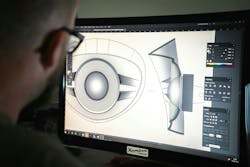Simulation-led Design Doesn’t Just Speed up Design—it Future-proofs it
Even with robotics, traditional development and production are time-consuming and error-prone. You can optimize downstream workflows with computer-aided design (CAD) and computer-aided engineering (CAE) software. Understanding their synergy can help you maximize the benefits of integrating CAE into CAD.
Understanding the Importance of CAE Simulations
Conceptualization and development are relatively inexpensive compared to marketing, manufacturing and distribution. However, each one of your design decisions has significant financial implications. While the design phase comprises just 5% of a product’s cost, it determines 70% of your production expenses.
Everything from component shape to material choice has far-reaching implications, complicating performance and profitability forecasts. Like many design engineers, you likely use CAD/CAM software to streamline the process, mitigating unnecessary costs.
It effectively translates your design, improving your product quality and trimming your workload. It facilitates seamless workflows—especially in CNC machining—by producing manufacturing instructions that optimize toolpaths, reduce material waste and eliminate human error.
Although this software facilitates a perfect, realistic visualization and seamlessly executes production processes, it lacks a key element: simulation-based testing and analysis. A CAE platform simulates product performance, virtually evaluating three-dimensional CAD models to eliminate the need for expensive physical prototypes.
It processes geometry to assess components or whole systems, enabling it to predict performance outcomes under various conditions. Instead of viewing each development phase as a siloed process, you should combine them.
READ MORE: Optimizing Machine Performance with Variable Frequency Drives
Why You Should Consider Simulation-led Design
Traditionally, you would generate fit-for-purpose CAE models from complex CAD assemblies in a drawn-out, iterative process. This method is error-prone and time-consuming because it involves isolating components of interest and correcting disparate interfaces. Waiting for feedback from other departments can turn a simple project into a days-long endeavor.
Importing a CAD model into your CAE software requires you to clean up the geometry to ensure compatibility—only then can you run an analysis. You would typically need multiple iterations to generate an effective prototype.
In simulation-led design (SLD), you test your design choices early in the product life cycle. Embedding CAE tools within the CAD environment enhances ease of use and streamlines adoption. This product development approach involves conducting analyses to determine the optimal configurations, saving you time and money.
Say you work in the automotive industry and must design various automobile parts. With CAD/CAE software, you could tell which material would make the vehicle lighter without sacrificing driver safety. Alternatively, you could determine whether components would crack when subject to thermal fatigue.
Approaching conceptualization, testing and production from a centralized location doesn’t just help you—it also improves downstream workflow. The benefits of integrating CAE into CAD are abundant.
Exploring the Benefits of Integrating CAE into CAD
SLD helps you move away from a reactive approach by enabling you to detect design flaws early, preventing costly late-stage changes. You can tweak variables within minutes, simulating as early and often as needed to perfect your product. This is a far cry from the conventional method involving physical prototypes, where initial prototyping and redesign take weeks.
Research shows combining CAD, CAE and CAM can improve design accuracy by reducing human error. Also, it increases efficiency and productivity. These benefits translate to optimized material usage and streamlined production, resulting in considerable cost savings.
Improved collaboration is another benefit of CAE in CAD. It eliminates the knowledge siloes between you and other departments. Instead of exchanging information and waiting days for feedback, you work together using a centralized platform.
Since these tools allow you to evaluate numerous test scenarios rapidly, you can easily develop a design that reduces manufacturing expenses without increasing your prototype iteration volume or impacting product performance. In addition to improving product reliability, you shorten your time-to-market.
READ MORE: How “Smart” Components are Getting Smarter: Valves, Bearings, Gearboxes and Brakes
Simulation-driven Design Future-proofs Products
There are multiple ways you would benefit from embedding CAE in CAD. SLD doesn’t just accelerate development; it future-proofs it. The faster and more cost-effective your prototyping process is, the sooner you can explore new initiatives. You can corner the market this way.
Integrating CAD with simulation and evaluation techniques like multibody dynamics, finite element analysis (FEA) and computational fluid dynamics (CFD) allows you to assess stress, flow and force, helping you fine-tune your engineering process.
Moreover, since testing potential scenarios—including edge cases—is affordable and straightforward with CAD and CAE platforms, you can ensure every component is resilient to changing conditions. You can improve your organization’s brand perception by making them adaptable to evolving standards, environments and technology integrations.
The benefits of CAE in CAD are long-lasting. A faster time-to-market and enhanced brand perception would improve your competitiveness, potentially increasing sales. You could use those funds to produce more unique, sophisticated solutions, further cementing your employer’s place as an industry leader.
Emerging Trends Shaping CAD and CAE Software
Several emerging trends are poised to reshape CAD/CAE integrations. Artificial intelligence is among the most pressing. AI can combine data feeds to reproduce complex conditions, generating a comprehensive outlook for insights at a glance. For example, it could simulate crashworthiness instead of separately evaluating stress and thermal fatigue.
AI also makes plain language interactions possible. Instead of spending months or years training to become proficient, you only have to learn the basics. If you have a utilization or troubleshooting question, the model could answer. Moreover, it could automate most repetitive processes for you, effectively democratizing CAE.
AI can provide insight into alternative designs’ performance, dramatically accelerating the iteration process even if you test numerous hyper-specific scenarios. You wouldn’t need to run extensive simulations, improving your time-to-market.
Digital twin technology—powered by internet-enabled sensors—is another emerging solution shaping CAD and CAE. With these platforms, you can observe simulations under multiple performance conditions, enabling you to eliminate potential problems proactively.
Future-proofing is already among the chief benefits of CAE in CAD. These modern tools eliminate the guesswork entirely, allowing you to collect accurate, real-world data to leverage in your simulations. As a result, you will optimize processes, save money and accelerate innovation, helping you improve your product performance and quality exponentially.
READ MORE: AI Gains Physical Intelligence and Transforms Robotics & Automation Design
How Design Engineers Can Adopt This Solution
Your employer likely plans to increase their digitalization investment soon. In the 2021 Digital Transformation Assessment, nearly 70% of manufacturers told IBM they were accelerating their digital timetable. If so, you should make your case for SLD to reap the benefits of CAE in CAD.
Even with board buy-in, you must approach implementation carefully—there is more to effective simulation than realistic graphics. Your platform must reliably predict engineering variables, have adequate security features and be cost-effective to integrate. A turnkey solution is the best option for most manufacturers.
You should also consider how to integrate CAD plugins into CAE workflows. Will you need CFD, multibody dynamics or FEA? Once you select what you need, configure it correctly and validate the results to ensure accuracy. Remember to optimize your workflow to reduce the manual labor required for simulation and analysis.
To get the maximum benefit from CAE in CAD, you must review everything from ease of integration to potential vendor lock-in. Participating in emerging trends by leveraging machine learning or digital twin functionality is also worth considering.
Maximizing the Strategic Value of an SLD Integration
While the strategic benefits of embedding CAE in CAD are clear, you should carefully review your needs, budget and existing workflows to develop a foolproof implementation plan. This way, you spend less time putting out metaphorical fires and more time generating value.
About the Author

Emily Newton
Emily Newton is a technology and industrial journalist. She is also the editor in chief of Revolutionized. She has over five years covering stories about warehousing, logistics and distribution.
